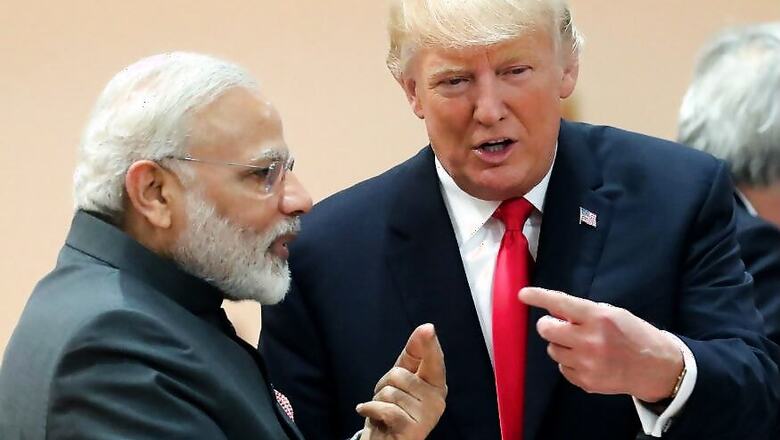
views
The postponement of the high level ‘2+2 dialogue’ between India and the US yet again has resulted in a flurry of commentaries, with some even suggesting a crisis in the bilateral.
The public differences on key issues, ranging from trade, to work visas and the Iran sanctions, coupled with questions around the personal chemistry between PM Narendra Modi and US President Donald Trump have left many speculating on the future of this relationship. While this may be an over-reaction, we must use this opportunity to reflect and analyse the state of the bilateral and assess if we are indeed heading into choppy waters.
It is worth reiterating some characteristics and realities that have shaped the India-US partnership in recent decades. The transformational changes in world politics through the 1990s were important and sparked a realisation in both capitals that investing in each other was a priority. Overtime, top-level political leadership in both countries have translated this into a sustained partnership with great potential to shape regional and global affairs.
China’s rise only accelerated this strategic partnership, especially in the Western Pacific and the Eastern Indian Ocean, leading to the conceptualisation of the ‘Indo-Pacific’ region— its importance reinforced by the rechristening of the US (Indo-) Pacific Command.
Throughout this, American ambivalence to the India-Russia relationship, and a willingness by both countries to temporarily set aside differences on Pakistan, Iran and economic policy allowed them to strengthen the bilateral agenda.
Today, the assessments in Delhi and Washington DC are visibly changing — in terms of the how the world is ordered, what the new covenants must be, and indeed, in their expectations of each other. It is, therefore, necessary to consider what has changed, what remains unchanged, and what is needed now.
For one thing, there is little evidence that would suggest any dilution in the investments that both PM Modi and President Trump have made in this relationship. While enthusiasm at the political leadership level is welcome, recent events suggest that the perception of ambivalence at the top may well give bureaucracies in both countries the opportunity to revert to the old policies of the 1970s and 1980s.
Which is why Washington and New Delhi must now interrogate if such a top-down structure for this important relationship is sustainable and if the relationship needs more champions. While both countries have done well to institutionalise their relationship over the past two decades, the economic and political demands on this partnership are going to grow manifold — and it is now necessary to strengthen and expand these structures in order to sustain continuity irrespective of the prevailing political mood.
Second, the Russia question continues to vex the foreign policy establishment in both countries. While India’s dependence on Russia for defence products reduces, the fact is that it will remain a key security partner for many years to come. At the same time, Moscow will increasingly become an important actor for India’s political, connectivity and energy projects in Eurasia. To sustain a long-term India-US partnership, it is now time for both countries to adopt a mutually accommodative position on Russia.
The US, for its part, must be flexible and account for the important role Russia plays in India’s security objectives. New Delhi, on the other hand, must invest diplomatic energy in convincing Washington to shed its cold war mentality towards Moscow and embrace an ‘entente cordiale’ with this superpower, especially as both countries begin to recalibrate their approach to China.
President Trump’s impending summit with President Putin this July is a welcome thaw in America’s orthodox approach to Moscow — a necessary move in the long-term, considering that neither India nor the US would benefit from Russia being in the Chinese corner.
Finally, and most importantly, it is time to enquire if the US can continue to unilaterally set the priorities for this relationship — and strong-arm India into accommodating its preferred posture on key issues such as Pakistan and Iran. The fact is that India’s economic growth will see its GDP surpass the US before the middle of this century on real terms and well before in PPP terms. This reality implies that New Delhi will increasingly set its own priorities and will retain independent beneficial relationships with countries like Iran and chart its own course with its neighbours.
How will the US establishment come to terms with the fact that for the better part of the 21st century, India will be the larger economic partner? More importantly, has Delhi realised the potential and consequences of this shift?
Already at the Shangri-La Dialogue, PM Modi outlined a vision for the Indo-Pacific that was distinct from Washington’s conceptualisation. With time, India will, and must, do the same on geo-economics, trade and in its pursuit of strategic partnerships.
In the end, India and the US must embrace their roles as the most consequential democracies of the 21st century. However, their current differences may well stem from adjusting to this reality and some others. Allowing such differences to snowball will be a very expensive mistake —especially as China wastes no time in executing its own agenda for the international order.
Indeed, now more than ever, Washington will need New Delhi to balance China’s rise, given the coterminous nature of India’s rise and its own relative decline.
Capitalising on the opportunity presented by the India-US partnership will require both countries to institutionalise dialogue and identify differences capable of derailing the relationship in the long-term. Elites in Washington and Delhi must realise that a partnership of equals will require a more finely tuned calibration of their foreign policy priorities.
(The author is President, Observer Research Foundation. Views are personal)
















Comments
0 comment